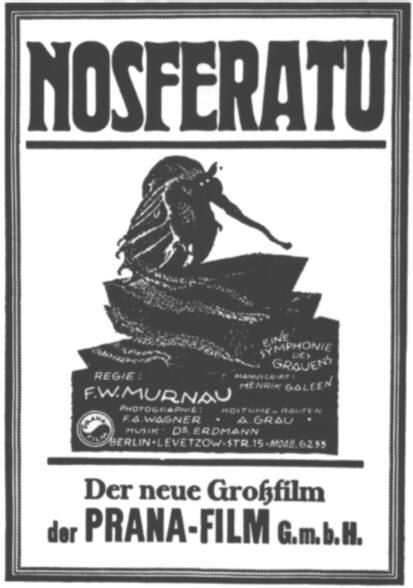
Starring: Max Shrek, Gustav von Wangenheim, Greta Schröder
Production Budget: unknown but small (it was 1921 after all)
Running Time: 88 min approx.
The first filmed version of Bram Stoker's Dracula, Nosferatu almost ceased to exist when Stoker's widow tried to sue the production company for copyright infringement (they declared bankruptcy) and had all 'known' prints destroyed. Being unable to secure the movie rights to Dracula, the producers had simply changed the names of the characters and hoped no one would notice that it was otherwise almost exactly the same. Fortunately, it has survived, and a number of different versions are floating around, some poor video transfers in black and white, and some, like the version I saw in the cinema, beautifully restored with colour tinting.
If you've seen any version of Dracula, or read the book, you already know the story: The Count (in this case Count Orlok) sends word to a local real estate agent that he wants to buy a house, so the agent sends a young employee to Transylvania to get the paperwork sorted out. While there, the Count sees a picture of the young man's wife, gets a bit peckish for her beautiful neck, and sets about making his way via ship to see her, while the young man rushes back overland to try and stop him.
I had not seen this film before, but I had seen Shadow of the Vampire, the fictionalised account of the making of Nosferatu (where it turns out the Shrek really is a vampire - or is he a big green ogre?), and combined with the many references and scenes that have made their way into other movies, T.V. shows and music videos (e.g. Under Pressure by Queen and David Bowie) meant I had already kind of seen a reasonable chunk of this movie. It was however nice to watch it in it's entirety, to get a feel for the pacing and how it all went together.
When watching a film like this, like looking at a classic painting, it is important to take into account the time and place in which it was created. With that in mind, I can forgive the bizarre acting (especially Wangenheim and his incredible overacting) and the extremely dated special effects (one ends up giggling at scenes such as one where Nosferatu's carriage comes racing through the forest in fast forward, which was probably terrifying at the time, but now gives it a Benny Hill feel), and concentrate on the brilliant performance of Shrek, and the
technical brilliance of the production.
Nosferatu is most effective when Shrek is on screen. The rest of the film drags a bit. He is only on screen for a few minutes total, so the audience doesn't get used to his bizarre appearance and mannerisms. Whether beautifully framed in a doorway, filmed as a shadow only or glimpsed staring out a distant window or rising from a coffin, every shot is awe inspiring. The way he stares out with those bulging eyes (he never blinks on-screen) is hypnotic, and creepy. It is very easy to see why his performance has been so admired/referenced/copied over the years.
I saw this film the Saturday before Halloween at the Arnolfini in Bristol, complete with live musical accompaniment by COMA. Having the live music certainly added to the experience, although I found it a bit too improvised, and lacking in melody. I haven't really experienced colour tinting on black and white films before, and it previously would have had me worried that it meant the kind of dreadful colourisation of black and white films that used to be popular in 70s T.V. versions. Actually, colour tinting was used extensively during the black and white era in order to evoke particular moods or lighting conditions. A great example in Nosferatu is that darkness is always represented as a blue tint, while dawn might be represented pink, and a forest at midday by green, etc.. It's all very subtle, and without this it would be impossible to recognise that Count Orlok only ever comes out at night: the technology back then made it impossible to actually film in low light.
I cannot promise that you will love (or even particularly enjoy - although I did) this film, but if you are interested in the origins of film and especially horror film, this is essential viewing. Nosferatu is now in the public domain, meaning it can be shared freely. So, you could watch the whole thing on, for example, Google Video, though if I were you I'd look out for it on the big screen. Otherwise you might mistakenly think it's crap.
$$$1/2

No comments:
Post a Comment